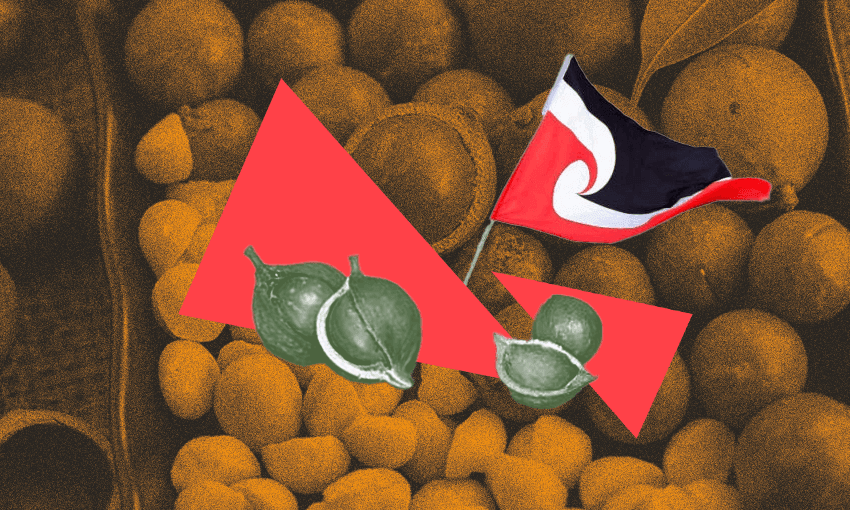After 35 years of trial and error, Tōrere Macadamias have turned the Australian nut into a platform for enacting Māori sustainability.
If you were asked about kai Māori, where would your thoughts drift? Probably kūmara, kaimoana, hāngī, fried bread and boil up. Definitely not macadamia nuts, which originated across the ditch. But Tōrere Macadamias, run by Ngāi Tai uri, are a world leader in their industry. They’ve used this Australian nut as a platform to become a successful business and to promote kaitiakitanga within the agricultural sector, Aotearoa’s most polluting industry.
Tōrere Macadamias features in season two of the Whakaata Māori show Home, Land and Sea, which explores how indigenous farming can be different and more sustainable than conventional agriculture. Producer Nicola Smith calls kaitiakitanga the guiding principle binding together the diverse tāngata whenua ventures featured in Home, Land and Sea. “Māori fishing, Māori farming, and farms led by whānau Māori all focus on sustainability and creating a resource for generations to come,” explains Smith. Other episodes of the show explore Māori fishing, honey, kūmara, truffles and whitebait operations.
“In 1983, my plan was to grow something on the land that wasn’t going to be detrimental to the land or the area,” says Vanessa Hayes, Tōrere Macadamias’ founder. They planted their first tree 35 years ago, and now they run the biggest macadamia orchard in Aotearoa: an 11-hectare ngahere with 1,500 mature trees and a nursery. But their orchard isn’t just country-leading, it’s world-renowned. Rui Shi, a top macadamia expert, claims Tōrere Macadamias are the world’s largest and tastiest. Despite its success, Tōrere Macadamias wants to double its operations.
Hayes’ son Walter Rika manages this whānau-operated business. His nephews and nieces help out, and his kids will too when they’re old enough. “I probably planted my first tree when I was about 11, and I got this connection with the place – it’s home,” he says. The orchard is located on their ancestral whenua, where an ancient pōhutukawa sits. “The tree itself was used [as a waka mooring] by our whānau many, many years ago when this area was covered in seawater”. More recently, the whenua (placenta in this context) of Hayes’ mokopuna was buried beneath the rakau.
Caring for their ancestral land makes Hayes’ whānau kaitiaki, tying Tōrere Macadamias into Home, Land and Sea’s sustainability theme. “I believe that macadamia is good for Māori to get into because it’s healthy, it’s organic, it’s a sustainable crop,” says Hayes. She spent decades determining the perfect macadamia varieties for New Zealand’s climate. Trial and error is critical to kaitiakitanga, which is based on empirical evidence, not just lab science. Hayes’ empirical methods identified six macadamia species perfect for Aotearoa. Another example of kaitiakitanga in action at Tōrere Macadamias is their sponsorship of a PhD student studying potential uses of their husks and shells to limit waste and greenhouse gas emissions (from decomposition).
By employing kaitiakitanga while growing macadamias, Hayes’ methods are informed by mātauranga Māori. For example, Tōrere Macadamias’ work is dictated by the ebbs and flows of the maramataka, which Hayes sees as key to their success. “Every month, we graft for 10 days leading up to and just coming off the full moon,” she explains. But another key kaitiakitanga practice which is often overlooked is its social obligation to bring people together for their, and the land’s, benefit. Hayes, however, doesn’t ignore this tikanga, as she founded the “Mātaatua Macadamia Collective” to enable other tāngata whenua to also grow the crop.
Mātaatua Macadamias Collective chairperson Hemana Waaka, who now grows the crop in Ruatoki, said, “What’s important to me is the wairua of the land, the whakapapa of the land, look after your land and who better to look after your land than yourselves.” Hayes outlined that the collective currently has 65 combined hectares of orchards, but their 2029 goal is 500. Fifteen land trusts are ready to go. Many were drawn to macadamias over environmental concerns – like the Akurangi whānau, who ran out of water for traditional farming. As Waaka explains, “Once the tree is in the ground, you don’t have to worry about water.”
Of all things, Covid-19 spurred the collective’s growth. During the pandemic, “with a lot of Māori coming home through that period, they all wanted to do something with their land,” says Hayes. She is stoked that more Māori are growing macadamias because Tōrere Macadamias alone can’t supply “the lucrative markets that are around in New Zealand. We don’t have enough to supply the chocolate makers, the ice cream makers, the muesli makers, the cereal makers.”
With the Mātaatua Macadamia Collective succeeding under Hayes and Waaka, the former’s son has a bold prediction. “The future for macadamias, I think it’s going to be looking very bright. I think there’s a lot of potential for our country and our peoples.”
Episodes of the second season of Home, Land and Sea come out on Mondays between February 19 and April 1 at 7.30 pm on Whakaata Māori and Māori+.
This is Public Interest Journalism funded by NZ On Air.

